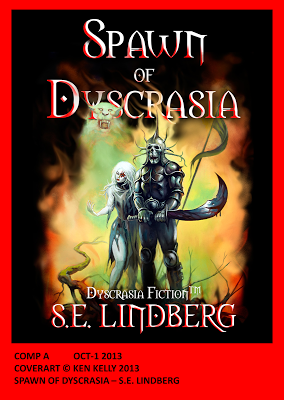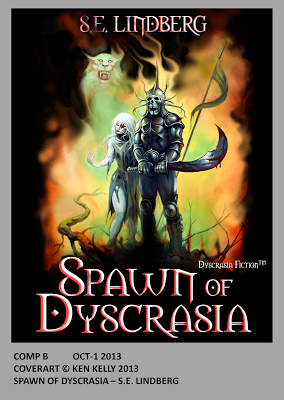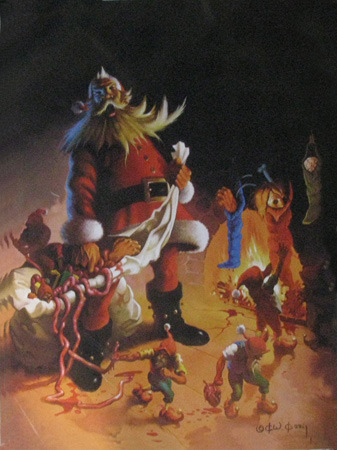S.E. Lindberg's Blog, page 58
October 31, 2013
Goodreads Sword & Sorcery Topics for Nov-Dec 2013: Kane and Obscure Books

All Sword & Sorcery Groupies, the poll is done and the two Groupreads Topics for Nov-Dec 2013 are:
1) Obscure Books:
Link = https://www.goodreads.com/topic/show/...
2) And Karl Edward Wagner's Kane,
Link to groupread here: https://www.goodreads.com/topic/show/...
Please join us! The banner is a montage of coverart; artist credits below:
Frank Frazetta's work shown:
Bloodstone, 1975
Dark Crusade, 1976
Night Winds, 1978



Ken Kelly's cover for the Nightshade edition of:
Gods in Darkness: The Complete Novels of Kane, 2002.

Published on October 31, 2013 21:30
October 14, 2013
Imaro - Sword & Soul - Review by S.E.
 Imaro by Charles R. Saunders
Imaro by Charles R. SaundersS.E. Lindberg rating: 5 of 5 stars
Quality Adventure with Legendary Context
Style & Legendary Motivations
This unique blend of Lovecraft & African mythology features a Conan-like hero. It’s pulpy style & storytelling may merit 4 stars: its uniqueness & place in literature boost it to 5.
Imaro is adventure in the vein of vintage, pulp periodicals. Expect heavy doses of sorcery & horror at a brisk pace. Unlike traditional pulp stories, these chapters are slightly less-episodic and more-chronological. In other words, Imaro is more of a continuing character versus Howard’s original Conan publications. Adventure tropes that could be called “cheesy” are compensated well with engrossing, visceral battle scenes and bestial sorcery. In fact, I was reminded of James Silke Frazetta’s Death Dealer series and thought Charles R. Saunders was much more effective at a milieu including jungle/savannah beasts. Saunders’ Imaro felt more Frazetta-like than Gath in Prisoner of the Horned Helmet or Tooth and Claw.
An excerpt from Saunders’s Into to Milton Davis’s Griots: A Sword and Soul Anthology best reveals the author’s passion:
Robert E. Howard and his contemporaries were products of their time. Racism, in the form of white supremacy, was an integral part of the popular culture of the early decades of the twentieth century, and as such it pervaded pulp fiction. As a product of a later time during which the tenets of racism came under vigorous challenge, my enjoyment of fiction from past decades was often compromised by the racial attitudes I encountered in my reading. On some occasions, I simply let it slide. On others, I wrestled with resentment. Then I discovered a way to resolve my dilemma.Saunders executed his dream very well, uniquely adding to adventure literature & steering how African mythology is conveyed with entertaining fiction. He coined the term “Sword & Soul” and effectively started a new subgenre. Wow! I would argue that he was so effective at writing that he depicted an almost darker Nyumbani continent (i.e. Africa), albeit one based more on history & substance rather than racism. Saunders’ sensitivity toward enslavement and genocide motivated him to replace his longest chapter (Book 3: Slaves of the Giant Kings) when Nightshade printed the second edition. He replaced it with “The Afua” which is said to be impressive, but I am still hunting down my own copy.
Interest in African history and culture surged during the 1960s, and at the same time I was reading sword-and-sorcery and fantasy fiction, I was also absorbing heretofore-unknown information about a continent that was not “dark” as its detractors made it out to be. I realized that this non-stereotypical Africa of history and legend was just as valid a setting for fantasy stories as was the ancient and medieval Europe that served as the common default setting for everything from Conan to Lord of the Rings. A character came into my head then: Imaro, a black man who could stand alongside mythical warrior-heroes like Beowulf and Hercules, as well as fictional creations such as Conan and Kull.
1981 Imaro Edition Contents:
• Book 1: Turkhana Knives
• Book 2: The Place of Stones
• Book 3: Slaves Of The Giant Kings (replaced with “The Afua” in the 2006 edition)
• Book 4: Horror in the Black Hills (Cover for 1986 based from this chapter)
• Book 5: The City of Madness (this is not in the 2006 edition of “Imaro-1” from Nightshade…but does appear in the first chapter in Nightshades’ “Imaro-2” renamed Mji Ya Wzimu its original title in from a 1974 publication in Dark Fantasy...actually, the Nightshade edition offers a different chapter in its place called Betrayal in Blood.)
Imaro
Through these five chapters, Imaro evolves from being a fatherless, abandoned child (desiring to belong to a community)… into a vengeful, tribe-less Hercules-like figure (set on destroying evil forces). An excerpt captures his presence best:
The Illyassai was a fearsome sight. His dark skin glistened sweat-slick through garments that hung in skimpy tatters from his massive frame. Crimson-crusted wounds scored his body like glyphs inscribed by devils. Dried blood matted his wooly hair. His face was hardened into an implacable mask of hatred. Unrequited vengeance flickered like a torch In his eyes, yet beneath the lamina of that emotion lay a core of grief so bitter it threatened to consume him entirely…Imaro vs. Lovecraftian “Mashataan” Sorcery:
Each story compounds the conflict of Imaro versus the being Mashatann, whose minions or followers assume mythological status:
Elephantine legs rose like wrinkled trees from the ground, Long bony arms hung like sticks from a pair of, knobby shoulders. The hands were incongruously delicate and graceful. Other than his head, those hands were the only remotely human features [spoiler’s name] had left…Cover:
…Upon the dais hunched a bizarre image sculpted from pitted, gray-green stone. From the waist up, the creature the sculpture depicted resembled Ngai the gorilla, although its skin was hairless and its wide mouth bore fangs even longer than those of the red panther Imaro had slain. It was the lower extremities of the unknown beast’s body that marked it as something alien to the world of natural beings. Its legs were the hindquarters of Mboa the buffalo: thick, muscular haunches tapering to sharp, lethal hooves.
The 1981 cover by Ken Kelly captured the tone, but seems to have some glaring disconnects: the cover depicts Book Four Horror in the Hills, but has a hero that appears non-African and the creature approximates the primary antagonist...but is of the incorrect gender. The NightShade’s edition of Imaro-1, has a beautiful illustration by Vince Evans, but given the color-palette & the lack of magic & creatures, appears to showcase a Historical-Fiction novel rather than Fantasy-Fiction. Perhaps some of those design features were intentional marketing concepts.


Finding A Copy:
The series Imaro continues with 3 more books: Imaro 2 : The Quest for Cush, The Trail of Bohu, Imaro: The Naama War, available from Lulu.com. Mshindo Kuumba has emerged as Saunder’s go-to artist for these. Click here to go to Saunders’ website to locate books: Where to purchase new Saunders books



Although the first two Imaro books from DAW were reprinted in ~2006 by Nightshade, they are difficult to find now (2013). Used bookstores are your best bet. Ebooks are being developed according to a very credible source, that being virtual-brother-to-Saunders, Milton Davis, who edited Griots: A Sword and Soul Anthology, the foundational Sword & Soul anthology). He recently commented on the Sword & Sorcery Group on Goodreads - LINK
Milton Davis: Charles's current publisher is working on e-book versions of the Imaro books. There's a new Imaro story in Griots and a new Dossouye story in the upcoming Griots: Sisters of the Spear anthology. And to top it all off, I plan to publish the first book (or two) in a new series by him entitled 'Abengoni.
Sword & Soul is highly recommended to fantasy-fiction readers!
View all my reviews
Published on October 14, 2013 07:41
October 1, 2013
Ken Kelly - Cover Art for Spawn of Dyscrasia
Spawn of Dyscrasia Coverart by Ken KellyThe sequel to the horror-fantasy novel
Lords of Dyscrasia
is
Spawn of Dyscrasia.
It is on track for a 2014 release.
The commissioned cover art from artist Ken Kelly (Bio) just arrived. Expect more posts soon documenting the design process. If you think you are not familiar with his art, browse his gallery Ken Kelly (gallery); you likely have his coverart in your library.
Two draft compositions of the Spawn of Dyscrasia cover are below. Thanks go out to my partner in crime, Heidi, who has a flare for fonts & lettering. She will be tidying the design as the cover develops.
Spawn of Dyscrasia - S.E. Lindberg / Covert Art © Ken Kelly 2013
 COMP ASpawn of Dyscrasia - S.E. Lindberg - Covert Art © Ken Kelly 2013
COMP ASpawn of Dyscrasia - S.E. Lindberg - Covert Art © Ken Kelly 2013
 COMP BSpawn of Dyscrasia - S.E. Lindberg - Covert Art © Ken Kelly 2013
COMP BSpawn of Dyscrasia - S.E. Lindberg - Covert Art © Ken Kelly 2013
The commissioned cover art from artist Ken Kelly (Bio) just arrived. Expect more posts soon documenting the design process. If you think you are not familiar with his art, browse his gallery Ken Kelly (gallery); you likely have his coverart in your library.
Two draft compositions of the Spawn of Dyscrasia cover are below. Thanks go out to my partner in crime, Heidi, who has a flare for fonts & lettering. She will be tidying the design as the cover develops.
Spawn of Dyscrasia - S.E. Lindberg / Covert Art © Ken Kelly 2013
 COMP ASpawn of Dyscrasia - S.E. Lindberg - Covert Art © Ken Kelly 2013
COMP ASpawn of Dyscrasia - S.E. Lindberg - Covert Art © Ken Kelly 2013 COMP BSpawn of Dyscrasia - S.E. Lindberg - Covert Art © Ken Kelly 2013
COMP BSpawn of Dyscrasia - S.E. Lindberg - Covert Art © Ken Kelly 2013
Published on October 01, 2013 05:07
September 7, 2013
Bitter Steel, Sword and Sorcery by Gramlich - Review by S.E.
 Bitter Steel: Tales And Poems Of Epic Fantasy by Charles Allen Gramlich
Bitter Steel: Tales And Poems Of Epic Fantasy by Charles Allen GramlichS.E. Lindberg rating: 5 of 5 stars
An anthology of dark adventure; highly recommended.
Epic Content: Sub-genre purists would clarify that the inclusion of “Epic” in the title inappropriately evokes long-winded, 2000page fantasy sagas; this anthology does feature 20 items of epic qualities, but these are discontinuous, compact doses of horror adventure (weird, pulp fiction). Most poems and tales were published previously. A table below sorts the order of presentation vs. publication and serves as a tour-guide for adventurous readers. The contents are organized well if you decide to tackle this linearly; a timely intermission of three humorous tales appears two-thirds the way through. After that, a few more doses of dark Sword & Sorcery leads into the final poem, an appropriate, haunting dedication to Robert E. Howard.
Author: Charles Allen Gramlich is a college professor of psychology (also teaching “writing for psychologists”); he extends his passion for teaching writing into the speculative fiction arena too (i.e. see Write with Fire: Thoughts on the Craft of Writing). He is also a scholar of the Sword & Sorcery genre, having been a member of REHupa (Robert E. Howard United Press Association). Personal annotations transition many of the tales/poems in Bitter Steel. These almost recast the anthology as a bibliography/teaching-text for future authors. As an example: the theme of lost fathers and sons is persistent throughout, and Gramlich confesses in his tour-like annotations that this stems from his losing his father as a teenager.
Emotive Style: The author’s psychology expertise enables him to his infuse his prose with emotive flare. This sometimes manifests in characterization, but more often affects his poetic tone (best represented by excerpts, like the ones below). Although he claims to have been inspired primarily by Howard and Wagner, he appears influenced by Clark Ashton Smith too. I was first introduced to Gramlich via his short story Harvest of War (highly recommended), which shares the style here: poetic cadence, with dark content, a fast read despite its depth.
In this collection, protagonists range from barbarian warriors, to anti-hero kings, to pathetic necromancers. Side characters are far from being shallow, many being deformed or mutilated with plenty of their own motivations. The Thal Kyrin yarn (6 tales) is a highlight. Thal adventures on Thanos, a version of Earth long after an alien race colonized it. No worries fantasy fans, this is not sci-fi. The foundation is obscure and mysterious, reminiscent of Lovecraftian cosmic horror. Here are some examples:
Undertones of Cosmic Horror
Cloudy tears of darkness began to pour from the eyeless face of the moon, and the normal white light of that orb began to shimmer and alter, from pearl, to gray, to bloody red. And when it was all red, the color poured out into the surrounding clouds, igniting crimson lightning that cracked wide the night. The people in the tiers, the shades of Karillon, gasped and fell to their knees, hiding their faces as their God began to materialize out of the storm. Wings unfolded from tattered cumulus streamers; eyes blinked open with thunder. In another moment, bladed talons extended beneath the mass and the shape of a giant raptor was born.Poetic, Grim Prose:
In the bitter twilight of frost-rimmed peaks, Thal dreamed, the visions crimson with gore. War-horses frothed at their bits, eyes rolling like bloody pearls. Men in bruised armor and torn silks of umber and white hacked each other into ragged scarecrows. Arrows sleeted the sky like sharpened flakes of ice. When it was over the ravens gathered, scarcely moving as Thal rode among them searching. He found [spoiler]’s head on a stake.A Whisper From a Muse: More Thal?
Many know that REH was inspired to write Conan as if the barbarian was literary standing behind him, encouraging him to chronicle his tales. Gramlich was similarly inspired by the muse of Thal Kyrin. He does not apologize for discontinuities between the tales, but instead employs his annotations to spur our imaginations. Bitter Steel was released in 2010, and readers have yet to see more Thal in print. However, just this year (2013) Gramlich published "A Whisper in Ashes" (on Heroic Fantasy Quarterly e-zine) another accessible, poetic adventure inspired by Wager and Howard. Personally…I suspect the nameless warrior Krieg from Whisper in Ashes is actually Thal wandering, chasing ghosts and abandoned pyres. In any event, Bitter Steel is a great anthology.
Table of Contents:
Item Title Category First Published
1 “Recompense Reprise” Poem Niteblade, 2008
2 “A Gathering of Ravens” Standalone Tale: female lead Deep South Writers Conference: The Chapbook, 1991
3 “The Horns of the Air” Poem Deep South Writers Conference: The Chapbook, 1990
4 “Of Sake and Swords” Prose Poem Warrior Poets, 1997
5 “You Were There” Poem Bitter Steel, 2010
6 “Dark Wind” Thal Kyrin -1 Welcome to Suburbia, 2007.
7 “In the Memory of Ruins” Thal Kyrin -2 Shadow Sword, 1996.
8 “Wine and Swords” Thal Kyrin -3 Shadow Sword, 1997.
9 “Coin and Steel” Thal Kyrin -4 Bitter Steel, 2010
10 The Evening Rider Thal Kyrin -5 Shadow Sword, 1995.
11 “Sword of Dreams” Thal Kyrin -6 Fantastic Realms, 1992
12 “Smoke in the Blood” Poem Warrior Poets, 1997.
13 “Worms in the Earth: Barbarian’s Bane” Humorous Adventure Dragonlaugh, 2001
14 “Mirthgar” Humorous Adventure Strange Worlds of Lunacy, 2008
15 “Slugger’s Holiday” Humorous Adventure Beacons of Tomorrow, 2006.
16 “Luck and Swords” Standalone Tale Classic Pulp Fiction Stories, 1999.
17 “Sundered Man” Standalone Tale Bitter Steel, 2010
18 “A Flock of Swords” Standalone Tale Warrior Poets, 2000
19 “In Cold Desert Light” Poem The Barsoom Poet’s Corner, 1997.
20 “Cross Plains Conjure Man” Poem Star*Line, 2001
View all my reviews
Published on September 07, 2013 12:47
August 31, 2013
Imaro and Review Starved Books

The Sword & Sorcery Goodreads Group for the two month duration (Sept-Oct) are below. Please join us!:
Imaro: Sword & Soul by author Charles R. Saunders : Link to discussion (click here)Review-Starved Sword & Sorcery books: It is time to advocate the Sword & Sorcery genre, and enable future readers with some reviews/ratings. Seek out some new or vintage books that are not represented well (i.e. have less than ~20reviews), post some feedback on the book's page and here! Link to that discussion (click here).Again, I put together a montage banner (masthead) drawing from Saunder's coverart. Credits, from Left to Right:
"Imaro" Coverart by Ken Kelly 1981"Imaro II Quest for the Cush 1984" coverart by James Gurney"Dossouye" coverart by Mshindo Kuumba 2008
 ,
,


Published on August 31, 2013 23:30
August 29, 2013
Ken Kelly - Seasons Greetings
I commissioned Ken Kelly to make the cover art for the sequel to Lords of Dyscrasia, and the painting is due shortly. When the cover art is completed, I will share a blog post chronicling the design.Expect more updates on the sequel soon. The target publishing date is early 2014.
Ken Kelly is a famous fantasy artist who studied under the legendary Frank Frazetta. Kelly has become a legend himself; browse his oil painting gallery and you will recognize the Horseclan covers, tons of Conan covers, etc.
Of course I have a hobby creating Season Greeting cards (link to S.E.'s card gallery), sometimes with a dark twist...and sometimes with an aim to mimic Frazetta (see 2010 card), but I never approached the darkness Ken Kelly presented so well in "Seasons Greetings". I have already started this year's card (yes, I know it is only August, but my Fall schedule is busy). No worries...my card will not be this dark. Link to Ken Kelly's Seasons Greetings Painting Season's Greeting - Ken Kelly
Season's Greeting - Ken Kelly
Ken Kelly is a famous fantasy artist who studied under the legendary Frank Frazetta. Kelly has become a legend himself; browse his oil painting gallery and you will recognize the Horseclan covers, tons of Conan covers, etc.
Of course I have a hobby creating Season Greeting cards (link to S.E.'s card gallery), sometimes with a dark twist...and sometimes with an aim to mimic Frazetta (see 2010 card), but I never approached the darkness Ken Kelly presented so well in "Seasons Greetings". I have already started this year's card (yes, I know it is only August, but my Fall schedule is busy). No worries...my card will not be this dark. Link to Ken Kelly's Seasons Greetings Painting
 Season's Greeting - Ken Kelly
Season's Greeting - Ken Kelly
Published on August 29, 2013 07:16
August 17, 2013
Sunflower Pollen as Paint Pigment
Sun Flower Pollen - Pigment/PaintOur house is still ramping up its dye-making capabilities. The garden continues to grow to enough that we can now harvest the Madder roots without depleting the patch (started in 2011 –link to post). The basement will soon be a functional workshop, with plenty of lighting, a sink, electricity, and benches.
 Thanks to my wife’s gardening, we have plenty of sunflowers. Some are of the Hopi variety, the seeds of which have been used by Native American Indians to prepare purplish/gray dyes. Whereas I hope to make my own paints, she plans to dye fabric (DesignLab link); so expect a post later on the seed-dye making. Many flowers are brought into the house and drop pollen.
Thanks to my wife’s gardening, we have plenty of sunflowers. Some are of the Hopi variety, the seeds of which have been used by Native American Indians to prepare purplish/gray dyes. Whereas I hope to make my own paints, she plans to dye fabric (DesignLab link); so expect a post later on the seed-dye making. Many flowers are brought into the house and drop pollen.
Given the nature of pollen to be colorful, tiny, and sticky, I started collecting it to use as pigment. First we had to replace the fabric tablecloth beneath the vase that was being “painted”; aluminum foil worked well since the pollen did not adhere to it, and it could be folded into a funnel to deliver the pollen into a jar.
Sun Flower Pollen - MicrostructureTo learn about how it may work as a pigment, let’s have a look at the pollen grains: (1) dry, (2) in oil, and (3) in water. Below, the pollen-in-air color image is a brightfield microscopy image; to show the detail, differential interference contrast microscopy (monochrome image) was performed. Most were a-spherical (“not spheres”), but most were ~10microns in width (that’s ~1/10 the length of a human hair). Clearly their spikes help them to stick to substrates. The grains are a mixture from several sunflower plants. Most were yellow, but some were purple.
To make paint, pigments are dispersed into liquids. These host liquids are usually water-like or oil-like. Actually, microscopists often embed dry samples into liquids, to reduce scattering and improve imaging (this works if the samples do not react or transform in the liquid). These immersion tests reveal how these grains may be color-fast (or not). Turns out, the sunflowers lost their color in the oil; but their shell was maintained: this means that the pollen is filled with a hydrophobic liquid (dye), and that the shells are porous. Actually, the spherical grains seemed to leak less (I will have to investigate further if only certain sunflowers produce those). In water, the yellow dye was slowly replaced. It was shot out of the shell as drops. This confirms that the dye is hydrophobic, and that the shells are porous.
Turns out, the sunflowers lost their color in the oil; but their shell was maintained: this means that the pollen is filled with a hydrophobic liquid (dye), and that the shells are porous. Actually, the spherical grains seemed to leak less (I will have to investigate further if only certain sunflowers produce those). In water, the yellow dye was slowly replaced. It was shot out of the shell as drops. This confirms that the dye is hydrophobic, and that the shells are porous.
This work will inform a paint recipe. The observations are somewhat aggravating since they indicate it may be difficult to keep dye inside the grains whether a water-paint or oil-paint is made. For now, I will keep collecting the pigment and will lean toward design an aqueous host phase.
 Thanks to my wife’s gardening, we have plenty of sunflowers. Some are of the Hopi variety, the seeds of which have been used by Native American Indians to prepare purplish/gray dyes. Whereas I hope to make my own paints, she plans to dye fabric (DesignLab link); so expect a post later on the seed-dye making. Many flowers are brought into the house and drop pollen.
Thanks to my wife’s gardening, we have plenty of sunflowers. Some are of the Hopi variety, the seeds of which have been used by Native American Indians to prepare purplish/gray dyes. Whereas I hope to make my own paints, she plans to dye fabric (DesignLab link); so expect a post later on the seed-dye making. Many flowers are brought into the house and drop pollen.Given the nature of pollen to be colorful, tiny, and sticky, I started collecting it to use as pigment. First we had to replace the fabric tablecloth beneath the vase that was being “painted”; aluminum foil worked well since the pollen did not adhere to it, and it could be folded into a funnel to deliver the pollen into a jar.

Sun Flower Pollen - MicrostructureTo learn about how it may work as a pigment, let’s have a look at the pollen grains: (1) dry, (2) in oil, and (3) in water. Below, the pollen-in-air color image is a brightfield microscopy image; to show the detail, differential interference contrast microscopy (monochrome image) was performed. Most were a-spherical (“not spheres”), but most were ~10microns in width (that’s ~1/10 the length of a human hair). Clearly their spikes help them to stick to substrates. The grains are a mixture from several sunflower plants. Most were yellow, but some were purple.

To make paint, pigments are dispersed into liquids. These host liquids are usually water-like or oil-like. Actually, microscopists often embed dry samples into liquids, to reduce scattering and improve imaging (this works if the samples do not react or transform in the liquid). These immersion tests reveal how these grains may be color-fast (or not).
 Turns out, the sunflowers lost their color in the oil; but their shell was maintained: this means that the pollen is filled with a hydrophobic liquid (dye), and that the shells are porous. Actually, the spherical grains seemed to leak less (I will have to investigate further if only certain sunflowers produce those). In water, the yellow dye was slowly replaced. It was shot out of the shell as drops. This confirms that the dye is hydrophobic, and that the shells are porous.
Turns out, the sunflowers lost their color in the oil; but their shell was maintained: this means that the pollen is filled with a hydrophobic liquid (dye), and that the shells are porous. Actually, the spherical grains seemed to leak less (I will have to investigate further if only certain sunflowers produce those). In water, the yellow dye was slowly replaced. It was shot out of the shell as drops. This confirms that the dye is hydrophobic, and that the shells are porous. This work will inform a paint recipe. The observations are somewhat aggravating since they indicate it may be difficult to keep dye inside the grains whether a water-paint or oil-paint is made. For now, I will keep collecting the pigment and will lean toward design an aqueous host phase.

Published on August 17, 2013 04:55
August 9, 2013
The Harsh Suns - Review by S.E.
 The Harsh Suns by Jason E. Thummel
The Harsh Suns by Jason E. ThummelS.E. Lindberg rating: 4 of 5 stars
Jason E. Thummel proved he was an accomplished author of short story adventure with In Savage Lands, in which he delivered 13 quality Sword & Sorcery tales. Actually the author’s track record with publishing shorts via Blackgate and Rogue Blades Entertainment speaks to his merit. In addition to Thummel’s crisp writing, I have been attracted to his retro-vibe cover designs (artist Didier Normand painted covers for In Savage Lands and The Harsh Suns).
With The Harsh Suns, he develops a continuing character, chronicling the warrior Khal across three chapters (each essentially a short story). The focus is on warrior Khal’s quest to avenge his sister’s death. The primary conflict is “Kahl vs. evil-sorcerer Thanak Sul,” but there are recurring undertones of “Khal vs. gods/religion” which fortify the adventure with depth. Plenty of Sword & Sorcery delivered well. This is pulpy adventure, so you expect some arbitrary predicaments that keep the pace rolling.
The book essentially is an “origins” story that explains how Kahl becomes a wayfaring, god-cursed fighter. There is no explicit cliffhanger, but I was left expecting a sequel. I would welcome that.
View all my reviews
Published on August 09, 2013 14:30
August 6, 2013
Lords of Dyscrasia Giveaways - Summer 2013
Free Illustrated Dark Fantasy!Fifty Lords of Dyscrasia ePubs, PDFs, and Kindle Mobi's are being given-away on Librarything (until Septemebr 2nd 2013)!
And a tangible paperback is being offered on Goodreads! .goodreadsGiveawayWidget { color: #555; font-family: georgia, serif; font-weight: normal; text-align: left; font-size: 14px; font-style: normal; background: white; } .goodreadsGiveawayWidget img { padding: 0 !important; margin: 0 !important; } .goodreadsGiveawayWidget a { padding: 0 !important; margin: 0; color: #660; text-decoration: none; } .goodreadsGiveawayWidget a:visted { color: #660; text-decoration: none; } .goodreadsGiveawayWidget a:hover { color: #660; text-decoration: underline !important; } .goodreadsGiveawayWidget p { margin: 0 0 .5em !important; padding: 0; } .goodreadsGiveawayWidgetEnterLink { display: block; width: 150px; margin: 10px auto 0 !important; padding: 0px 5px !important; text-align: center; line-height: 1.8em; color: #222; font-size: 14px; font-weight: bold; border: 1px solid #6A6454; border-radius: 5px; font-family:arial,verdana,helvetica,sans-serif; background-image:url(https://www.goodreads.com/images/layo... background-repeat: repeat-x; background-color:#BBB596; outline: 0; white-space: nowrap; } .goodreadsGiveawayWidgetEnterLink:hover { background-image:url(https://www.goodreads.com/images/layo... color: black; text-decoration: none; cursor: pointer; }
Goodreads Book Giveaway Lords of Dyscrasia by S.E. Lindberg Giveaway ends October 07, 2013.
Lords of Dyscrasia by S.E. Lindberg Giveaway ends October 07, 2013.
See the giveaway details at Goodreads. Enter to win
"Pulp fantasy for the horror fan!" Beware, Lords of Dyscrasia is dark. How dark? Check out this review from a disturbed Goodreads reviewer: "...This is, without a doubt, the darkest book I've ever read. I don't have any problem with those sorts of things normally, but this was on a whole other level of twisted evilness. Murder, rape, cannibalism, drinking blood, necrophilia, necrophagia, demonic possession, and things involving children that I wish I had never read... You can try to compare it to Poe, who is dark, but not holy crap this is seriously effed up psycho dark…. In summary, this is an amazingly intricate and unique story line which is totally psychotic and I will never read it again…"
Looking for unique horror? Read on. : "...Outside of the works of Poe and Lovecraft, there are few, if any, novels comparable to [Lords of Dyscrasia]...Beowulf comes to mind both for its epic quality and bloody action...The pace is nearly breathless... Lindberg, who also created more than 50 illustrations and the cover for this book, makes the majority of current popular fantasy fiction read like recipes by comparison. Lords of Dyscrasia is highly recommended, though not for the faint of heart."Lords of Dyscrasia explores the choices humans and their gods make as a disease corrupts their souls, shared blood and creative energies. Historically, dyscrasia referred to any imbalance of the four medicinal humors professed by the ancient Greeks to sustain life. Lords of Dyscrasia presents them as spiritual muses for artisans, sources of magical power, and contagions of a deadly disease.
Learn more on S.E. Lindberg-Blog (Link)
And a tangible paperback is being offered on Goodreads! .goodreadsGiveawayWidget { color: #555; font-family: georgia, serif; font-weight: normal; text-align: left; font-size: 14px; font-style: normal; background: white; } .goodreadsGiveawayWidget img { padding: 0 !important; margin: 0 !important; } .goodreadsGiveawayWidget a { padding: 0 !important; margin: 0; color: #660; text-decoration: none; } .goodreadsGiveawayWidget a:visted { color: #660; text-decoration: none; } .goodreadsGiveawayWidget a:hover { color: #660; text-decoration: underline !important; } .goodreadsGiveawayWidget p { margin: 0 0 .5em !important; padding: 0; } .goodreadsGiveawayWidgetEnterLink { display: block; width: 150px; margin: 10px auto 0 !important; padding: 0px 5px !important; text-align: center; line-height: 1.8em; color: #222; font-size: 14px; font-weight: bold; border: 1px solid #6A6454; border-radius: 5px; font-family:arial,verdana,helvetica,sans-serif; background-image:url(https://www.goodreads.com/images/layo... background-repeat: repeat-x; background-color:#BBB596; outline: 0; white-space: nowrap; } .goodreadsGiveawayWidgetEnterLink:hover { background-image:url(https://www.goodreads.com/images/layo... color: black; text-decoration: none; cursor: pointer; }
Goodreads Book Giveaway
 Lords of Dyscrasia by S.E. Lindberg Giveaway ends October 07, 2013.
Lords of Dyscrasia by S.E. Lindberg Giveaway ends October 07, 2013. See the giveaway details at Goodreads. Enter to win
"Pulp fantasy for the horror fan!" Beware, Lords of Dyscrasia is dark. How dark? Check out this review from a disturbed Goodreads reviewer: "...This is, without a doubt, the darkest book I've ever read. I don't have any problem with those sorts of things normally, but this was on a whole other level of twisted evilness. Murder, rape, cannibalism, drinking blood, necrophilia, necrophagia, demonic possession, and things involving children that I wish I had never read... You can try to compare it to Poe, who is dark, but not holy crap this is seriously effed up psycho dark…. In summary, this is an amazingly intricate and unique story line which is totally psychotic and I will never read it again…"
Looking for unique horror? Read on. : "...Outside of the works of Poe and Lovecraft, there are few, if any, novels comparable to [Lords of Dyscrasia]...Beowulf comes to mind both for its epic quality and bloody action...The pace is nearly breathless... Lindberg, who also created more than 50 illustrations and the cover for this book, makes the majority of current popular fantasy fiction read like recipes by comparison. Lords of Dyscrasia is highly recommended, though not for the faint of heart."Lords of Dyscrasia explores the choices humans and their gods make as a disease corrupts their souls, shared blood and creative energies. Historically, dyscrasia referred to any imbalance of the four medicinal humors professed by the ancient Greeks to sustain life. Lords of Dyscrasia presents them as spiritual muses for artisans, sources of magical power, and contagions of a deadly disease.
Learn more on S.E. Lindberg-Blog (Link)
Published on August 06, 2013 04:57
July 17, 2013
Vance's The Dying Earth - Review by S.E.
 The Dying Earth by Jack Vance, S.E.lindberg rating: 4 of 5 stars
The Dying Earth by Jack Vance, S.E.lindberg rating: 4 of 5 starsVance's Prismatic Charm of Beautiful, Untiring Adventure
Review Summary: The Dying Earth, is beautiful, pulpy adventure. It is a series of six connected short tales (chapters), each being a mix of (Sword & Sorcery) and (Sword and Planet)...so consider it (Sword & Sorcery & Planet). And, it is an important classic, first published in 1950; Jack Vance's codification of magic items & spells proved influential in RPG-game design.
Dying Earth Series: Tales of the Dying Earth: The Dying Earth/The Eyes of the Overworld/Cugel's Saga/Rhialto the Marvellous is an omnibus edition of the four novels written by Jack Vance (1916-2013) between 1950 and 1986; the first is simply The Dying Earth, which is itself a collection of six short stories. With the recent passing of Jack Vance (1916-2013), the Sword and Sorcery Group is reflecting on his work this Summer (July-August): The Dying Earth (1950) is the first in the series (the next three in sequence are: (2) The Eyes of the Overworld (1966), (3) Cugel's Saga (1983), (4) Rhialto The Marvellous (1984)).




Codifying Magic - Role Playing Game (RPG)s: Tolkien maybe credited for inspiring "fellowships" of Dwarves, Elves, and Humans to go adventuring (a key trope for RPGs), but his magic-system was never codified well. Some ontology, or approach to classifying, was also needed ...and already provided, actually. Before "Lord of The Rings", Vance delivered The Dying Earth, and seems responsible for providing RPG-franchises with the needed approach: captivating brand names. Vance's Items and Spell titles simply exhibit self-evident credibility : Magic Items such as Expansible Egg, Scintillant Dagger, and Live Boots...and Spells such as Excellent Prismatic Spray, Phandaal's Mantle of Stealth, Call to the Violent Cloud, Charm of Untiring Nourishment. Three decades after The Dying Earth was published, the broader fantasy culture apparently caught on to the branding of spells and magic items (i.e. 1980's Dungeons & Dragons… or even magic-based card games like Pokemon, etc.).
Pace & Style: The title evokes gloomy adventure. The stories follow suit. The poetic, weird narratives will remind readers of predecessor Clark Ashton Smith (1893-1961)'s Lost Worlds; the swashbuckling adventure and planetary exploration evoke Vance's contemporary Roger Zelazny (1936-1995)'s The First Chronicles of Amber. Each tale moves at breakneck speed. Often times, within just one page, teleportation will propel the protagonist across multiple planetary systems and vast continents. Actually, the pace is too fast and the stories appear rushed (keeping this from receiving a 5-star rating). Most encounters involve some haggling/negotiating, and some of these lead to sudden brutality:
"Then you may die." And Mazirian caused the creature to revolve at ever greater speeds, faster and faster, until there was only a blur. A strangled wailing came and presently the Deodand's frame parted. The head shot like a bullet far down the glade; arms, legs, viscera flew in a direction." -- Ch2- Mazirian the MagicianThe brisk pace belies the serious, philosophical undertones that persist throughout. The milieu does involve the decline of earth, after all, but Vance does not dwell on it. The action is at the forefront, but darkness is continuously dosed. One moment he'll be describing some present urgency, and then he will sneak in a bit of epic, chronic darkness:
"At one famous slaughtering, Golickan Kodek the Conqueror had herded here the populations of two great cities, G'Vasan and Bautiku, constricted them in a circle three miles across, gradually pushed them tighter and tighter, panicked them toward the center within his flapping-armed sub-human cavalry, until at last he had achieved a gigantic, squirming mound, half a thousand feet high, a pyramid of screaming flesh."-- Ch2- Mazirian the MagicianBeauty Theme: The tales share many of the same characters, but each has a different protagonist. The protagonist from the six tale (Guyal) seems to speaks on behalf of the author's muses; he invites readers to consider:
"Where does beauty vanish when it goes?"Vance's work seems genuinely motivated by an appreciation of art and the mourning of lost beauty. He seemed to be following in succession from like-authors. Mary Shelley, Edgar Allen Poe, Clark Ashton Smith, H.P. Lovecraft all delved into evoking emotions through their art; they were serious writers who philosophized and wrote essays regarding "Weird Beauty" in literature. The undercurrents of dark muses in literary horror fascinate some (link). Below are excerpts and comments of Beauty's themes in The Dying Earth (per story):
Guyal's Father Answers: "Beauty is a luster which love bestows to guile the eye. Therefore it may be said that only when the brain is without love will the eye look and see no beauty." - Story 6- Guyal of Sfere
1) Turjan of Mirr: The books opens with a sorcerer trying to create living things. His craft, his art, is "life." He mirrors the plight of Victor Frankenstein:
"[Turjan] considered its many precursors: the thing all eyes, the boneless creature with the pulsing surface of its brain exposed, the beautiful female body whose intestines trailed out into the nutrient solution like seeking fibrils, the inverted inside-out creatures...Turjan sighed bleakly. His methods were at fault; a fundamental element was lacking from his synthesis, a matrix ordering the components of the pattern."Turjan needed more knowledge to complete his goal. This compels him toward making a woman who appreciates beauty (to compete with another woman who cannot detect beauty).
"For some time I have been striving to create humanity in my vats. Yet always I fail, from ignorance of the agent that binds and orders patterns."
"This is no science, this is an art, where equations fall to the elements like resolving chords, and where always prevails a symmetry either explicit or multiplex, but always of a crystalline serenity."
2) Mazirian the Magician: This chapter has significant overtones of Clark Ashton Smith's Maze of Maal Dweeb, Xiccarph tales (1935, 1930)...in which an alien sorcerer had the "caprice to eternalize the frail beauty of women," maintaining them in a garden. Here, the beautiful T'sain dies to save her maker, Turjan, in a magic-filled chase through an alien sorcerer's garden. This excerpt demonstrates how Vance never ceases to pour out the colors!
"Certain plants swam with changing iridescences; others held up blooms pulsing like sea-anemones, purple, green, lilac, pink, yellow. Here grew trees like feather parasols, trees with transparent trunks threaded with red and yellow veins, trees with foliage like metal foil, each leaf a different metal--copper, silver, blue tantalum, bronze, green iridium. Here blooms like bubbles tugged gently upward from glazed green leaves, there a shrub bore a thousand pipe-shaped blossoms, each whistling softly to make music of the ancient Earth, of the ruby-red sunlight, water seeping through black soil, the languid winds…"3) T'sais: The titular character, once an antagonist piece-of-art, searches out the ability to see beauty on Earth. As she describes:
"Pandelume created me," continues T'sais, "but there was a flaw in the pattern." And T'sais stared into the fire. "I see the world as a dismal place: all sounds to me are harsh, all living creatures vile, in varying degrees--things of sluggish movement and inward filth. During the first of my life I thought only to trample, crush, destroy. I knew nothing but hate. Then I met my sister T'sain, who is as I without the flaw. She told me of love and beauty and happiness--and I came to Earth seeking those."Etarr, an ugly companion of T'sais who had his hansom face switched with a demon's, goes with her to witness a Black Sabbath. As they watch the demons congragate, Vance philosophizes:
"Even here is beauty," he whispered. "Weird and grotesque, but a sight to enchant the mind."4) Laine the Wayfarer : Laine the arrogant magician is challenged to repair a piece of art: Lith's tapestry. Therein is depicted the Magic Valley of Ariventa, but is has been cut in half. Can he restore it?
5) Ulan Dhor: This is a fun piece, with more sci-fi than the others given the reactivation of ruined technology. The artistic elements are less covert here. There are two embattled groups that literally cannot see another. They signify themselves not with classic blazonry...but by simply by color: Green vs. Grays (vs. Reds)!
6)Guyal of Sfere: Guyal's insatiable search for knowing everything leads him on a quest to speak to the Curator of humankind's knowledge. En route, he partakes as a judge in a beauty pageant; here he meets with the maiden Shierl. They go on to explore sacred ruins, battle a demon who consumes beauty, and look upon the treasure trove of beauty, a sanctuary:
"This is the Museum," said Guyal in a rapt tone. "Here there is no danger...He who dwells in beauty of this sort may never be other than beneficent…"All in all, a recommended read to any sci-fi and fantasy buff, and to any reader who also likes RPGs. Feel welcome to join the discussion (at any time...even if the official group-read time expires):Group-Read Link.
View all my reviews
Published on July 17, 2013 14:49



